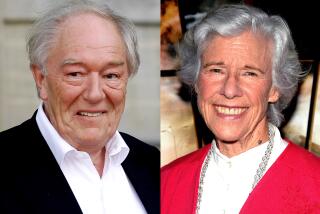David Merrick, Legendary Broadway Producer, Dies
Legendary theater impresario David Merrick, the notorious producer of such Broadway hits as “Gypsy,” “Hello, Dolly!” and “42nd Street,” has died.
Hindered by aphasia and required to use a wheelchair since a 1983 stroke, the 88-year-old Merrick died quietly in his sleep Tuesday morning in a London rest home, said Zack Manna, executive director of the New York-based David Merrick Arts Foundation.
By nearly four months, he outlived the theatrical century that he had a strong hand in shaping. He hired, bullied and then rehired Broadway’s best talents, producing classic American musicals and championing controversial dramas from abroad.
He produced more than 80 plays and musicals, winning six Tony Awards as well as two special Tonys for his contributions to Broadway and beyond.
Considered Broadway’s most successful producer, Merrick created a lasting theatrical legacy--making millions, grabbing headlines and leaving in his wake a trail of enemies and admirers (often the same people). He typified a kind of ruthlessness and vitality in New York theater that may now be gone forever.
The lights were dimmed on Broadway at 8 p.m. Wednesday in Merrick’s honor. The previous night, the lights dimmed in memory of the April 22 death of a Merrick rival, New York producer Alexander Cohen.
Merrick’s subdued final curtain call ran counter to every argument, advertising stunt and meaner-than-life story associated with his legend.
“David was very theatrical,” says Arthur Laurents, the librettist who worked with Merrick on “Gypsy” and “I Can Get It for You Wholesale,” the latter starring a fledgling Barbra Streisand. “He loved the theater, and there was nothing he wouldn’t stoop to” to sell his shows.
Indeed, he won admirers, alongside some eye-rolling skeptics, for his promotional zeal. To boost ticket sales for 1957’s “Look Back in Anger,” Merrick hired an actress to pose as an audience member and, during a performance, attack the man playing John Osborne’s rage-filled protagonist. The ploy worked, and box office sales improved.
After getting poor reviews for his 1961 musical “Subways Are for Sleeping,” Merrick invited people with the same names as the New York critics to see the show. He then took out an ad featuring rave notices from the non-critics.
The ads were eventually yanked.
“It’s not enough that I should succeed--others should fail,” said Merrick, who relished the role of tyrant.
A Merrick show generally entailed various trials by fire.
Songwriter and librettist Betty Comden, who worked with partner Adolph Green on two Merrick projects, said Wednesday that “we found him very difficult, very contentious--and very successful.”
In playwright Laurents’ new memoir, he characterizes Merrick’s producing philosophy as “basic Machiavelli: Keep the creative elements at one another’s throats and you’ll get their best work. And he admitted it.”
“That was what was disarming about David Merrick: He would admit anything--and then offer a disclaimer.”
Jerry Orbach, star of TV’s “Law and Order,” credits Merrick with giving him his Broadway break. Merrick and director Gower Champion saw Orbach in the off-Broadway phenomenon “The Fantasticks,” and later cast him in the musicals “Carnival,” “Promises, Promises,” and “42nd Street.”
“42nd Street” was Merrick’s last big hit, closing in 1989 after nearly 3,500 performances.
That show’s opening became an instant legend. Champion died of blood cancer hours before the curtain rose. Producer Merrick kept Champion’s death a secret from virtually everyone connected with the production.
After the triumphant opening night finale and curtain call, Merrick announced to a stunned house that Champion had died earlier that day.
Gordon Davidson, artistic director of Los Angeles’ Center Theatre Group, recalled that during an oceanside memorial service for Champion in Santa Monica, Merrick stood off to one side, apparently speaking to himself.
“Later I learned that he was talking to Gower directly,” Davidson said. “That was pure David. He didn’t want to go through anyone else.”
Began as Law Student
Despite his fearsome reputation as the “Abominable Showman,” Merrick inspired loyalty.
“We used to say we were working in Merrickland, which was certainly not a democracy,” said Josh Ellis, La Jolla Playhouse communications director, who served as press agent on several Merrick shows. “The stories of him fighting with critics and firing people were legion.
“But he could also be very loyal. He worked with the same tech people--propmasters, carpenters--for 20 years, and when they retired, he hired their kids.”
Merrick was born David Margulois in 1911 in St. Louis, the youngest of six children born to Samuel and Celia Margulois.
He was raised by one of his sisters after his parents divorced when Merrick was 10. He once said he tried to see “everything live that came to town.”
As a Washington University undergraduate, Merrick won second prize in a play-writing contest, outranking such fledgling dramatists as Tennessee Williams.
Merrick transferred to St. Louis University, where he studied law. He soon left the legal profession, and his despised hometown, for the New York theater.
In 1940, he invested $5,000 in the play “The Male Animal,” and the investment returned $20,000. In 1946, he went to work for producer Herman Shumlin as general manager. Though Merrick’s inaugural producing effort, “Clutterbuck,” failed, he scored a success five years later with the 1954 musical “Fanny.”
Receiving mixed notices, “Fanny” was kept alive and finally made successful by Merrick’s promotional talents. He commissioned a life-size nude statue of the show’s belly dancer that was placed in Central Park opposite a bust of William Shakespeare. These and other gimmicks helped “Fanny” coast to an 888-performance run.
Merrick scored again in 1955 with Thornton Wilder’s “The Matchmaker.” Merrick later musicalized the property to enormous popular success as “Hello, Dolly!”
“What he had was more than talent,” said Carol Channing, who won a Tony Award for “Hello, Dolly!” and who made the part of matchmaker Dolly Levi a signature role.
“It was a God-given gift that he had for showmanship,” Channing told Reuters in a telephone interview from Rancho Mirage, Calif.
Orbach recalled Wednesday his favorite memory of Merrick. “We were all in Washington with ‘42nd Street,’ before it went into New York. David had bought out the other two investors, so all the money was his.
“He was standing on the empty stage. I told him, ‘David, I’m having a poker game at the hotel. Do you want to play?’ He looked up at this huge set and said: ‘This is my poker game.’ ”
Eclectic Tastes
In his heyday Merrick enjoyed strikingly broad tastes.
In the same month in 1965, he supervised the Broadway premiere of Peter Weiss’ assaultive modern classic “Marat/Sade,” as well as the middle-of-the-road sex comedy “Cactus Flower.”
Throughout the 1960s he introduced American audiences to early works by Tom Stoppard (“Rosencrantz and Guildenstern Are Dead”) and Brian Friel (“Philadelphia, Here I Come!”).
The closing of Merrick’s “42nd Street” in 1989 signaled the end of an era. Increasingly during his lifetime, Broadway tastes began to favor the British mega-musical. Producing consortiums numbering in the dozens had become more common and solo acts like Merrick began to seem out of place.
No other producer could claim to have been punched by actor Nicol Williamson and to have sued the Tony Awards over the exclusion of a late effort, “State Fair,” in the new-score category.
Orbach said that, despite his negotiating tactics--”He got everybody as cheaply as he possibly could”--with Merrick in his prime, “you could put your faith in the idea that the show would be done the right way, top of the line.”
Producer Robert Whitehead, a contemporary of Merrick, credits Merrick’s tenacious and often riotous promotional gifts for “contributing something in the air today--that sense of how many different ways there are to sell tickets.”
Whitehead was outmaneuvered by Merrick more than once. “He was not a beloved competitor, but he was a skillful one. I don’t know if he was ever a very happy person. That sense of competition badgered him. I once went on a radio show with him and I remember he seemed devastated that I was being complimentary.”
Said Laurents: “Even though he worked very hard to get us all angry at each other, I found him a lot of fun. We made each other laugh.”
Ellis commented: “David loved the theater more than anyone I’ve ever known.”
Manna of the Merrick Arts Foundation said he continued to confer with Merrick about the foundation’s activities almost daily.
Long after retiring, Merrick attended new Broadway shows--often to his displeasure.
“He went all the time,” Manna said. “He’d talk less about the product and more about the fact that everything was becoming mass-produced. And he felt there were legions of producers as opposed to one general of the armies.”
Merrick married six times, twice to the same woman. His fourth wife, Karen Prunczik, played Anytime Annie in the original “42nd Street.”
In 1989, Natalie Lloyd, his lawyer’s receptionist, became Merrick’s live-in companion. The two were married last November. She was with him when he died.
Merrick’s body will be flown to the United States for a private burial. A memorial service will be announced at a later date.
Merrick is survived by two daughters from previous marriages, Cecilia Anne of Mullica Hill, N.J., and Marguerite of New York.
(BEGIN TEXT OF INFOBOX / INFOGRAPHIC)
His String of Broadway Shows
David Merrick produced more than 80 plays and musicals. Here is a partial list of his more noted productions and the year they opened in New York.
“Fanny,” 1954
“The Matchmaker,” 1955
“Look Back in Anger,” 1957
“Romanoff & Juliet,” 1957
“Jamaica,” 1957
“The World of Suzie Wong,” 1958
“La Plume de Ma Tante,” 1958
“Destry Rides Again,” 1959
“Gypsy,” 1959
“Take Me Along,” 1959
“Irma la Douce,” 1960
“A Taste of Honey,” 1960
“Becket,” 1960
“Do Re Mi,” 1960
“Carnival,” 1961
“Sunday in New York,” 1961
“I Can Get It for You Wholesale,” 1962
“Stop the World--I Want to Get Off,” 1962
“Oliver!” 1962
“Luther,” 1962
“110 in the Shade,” 1963
“One Flew Over the Cuckoo’s Nest,” 1963
“Hello, Dolly!” 1964
“Oh What a Lovely War,” 1964
“The Roar of the Greasepaint--The Smell of the Crowd,” 1965
“Inadmissible Evidence,” 1965
“Cactus Flower,” 1965
“Marat Sade,” 1965
“Philadelphia, Here I Come,” 1966
“Don’t Drink the Water,” 1966
“I Do! I Do!” 1966
“Rosencrantz and Guildenstern Are Dead,” 1967
“Promises, Promises,” 1968
“Forty Carats,” 1968
“Child’s Play,” 1970
“Sugar,” 1972
“Travesties,” 1975
“Very Good Eddie,” 1975
“42nd Street,” 1980
“State Fair,” 1996 *
Times staff writers Paul Lieberman, Elaine Dutka and Don Shirley contributed to this story.
More to Read
The biggest entertainment stories
Get our big stories about Hollywood, film, television, music, arts, culture and more right in your inbox as soon as they publish.
You may occasionally receive promotional content from the Los Angeles Times.










